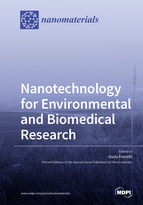Nanotechnology for Environmental and Biomedical Research
A special issue of Nanomaterials (ISSN 2079-4991). This special issue belongs to the section "Biology and Medicines".
Deadline for manuscript submissions: closed (20 July 2020) | Viewed by 66074
Special Issue Editor
Special Issue Information
Dear Colleagues,
Among the high production and broad feasibility of nanomaterials, the application of nanotechnology includes the use of engineered nanomaterials (ENMs) to clean-up polluted media such as soils, water, air, groundwater and wastewaters, and is known as nanoremediation. Contamination by hazardous substances in environmental matrices, including landfills, oil fields, manufacturing and industrial sites, represents a global concern and needs to be remediated since it poses serious risk for the environment and human health. Particular attention should focus on the use of medical devices and recent developments in the use of nanoparticles expressed as drug delivery systems designed to treat a wide variety of diseases. This Special Issue of Nanomaterials, “Nanotechnology for Environmental and Biomedical Research”, aims at collecting a compilation of articles that strongly demonstrate the continuous efforts in developing advanced and safe nanomaterial-based technologies for nanoremediation and drug delivery, for environmental and human health.
Dr. Giada Frenzilli
Guest Editor
Manuscript Submission Information
Manuscripts should be submitted online at www.mdpi.com by registering and logging in to this website. Once you are registered, click here to go to the submission form. Manuscripts can be submitted until the deadline. All submissions that pass pre-check are peer-reviewed. Accepted papers will be published continuously in the journal (as soon as accepted) and will be listed together on the special issue website. Research articles, review articles as well as short communications are invited. For planned papers, a title and short abstract (about 100 words) can be sent to the Editorial Office for announcement on this website.
Submitted manuscripts should not have been published previously, nor be under consideration for publication elsewhere (except conference proceedings papers). All manuscripts are thoroughly refereed through a single-blind peer-review process. A guide for authors and other relevant information for submission of manuscripts is available on the Instructions for Authors page. Nanomaterials is an international peer-reviewed open access semimonthly journal published by MDPI.
Please visit the Instructions for Authors page before submitting a manuscript. The Article Processing Charge (APC) for publication in this open access journal is 2900 CHF (Swiss Francs). Submitted papers should be well formatted and use good English. Authors may use MDPI's English editing service prior to publication or during author revisions.
Keywords
- Nanostructured materials
- Nanotoxicology
- Trojan horse effect
- Nanoremediation
- Ecosafety
- Drug delivery







